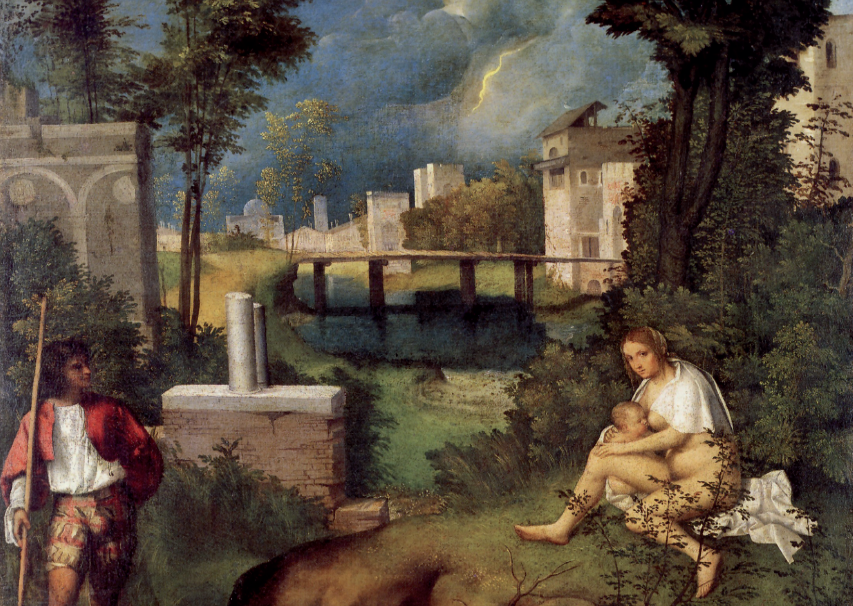Giorgione is perhaps one of the most enigmatic artists of the history of Western painting. His paintings, refined and personal interpretations of humanistic culture between the fifteenth and sixteenth centuries, often appear complex skeins of closely intertwined symbols that are difficult to solve with contemporary eyes.
The painting that perhaps, most of all, over time embodied the cryptic painting by Zorzi da Castelfranco, called Giorgione, is the so-called "The Tempest", the emblem framework of the Gallerie dell'Accademia in Venice. It is a small panel painted in oil, on which many pages have been written over the centuries in an attempt to give a meaning to the image. Recently, thanks to a study by Maria Daniela Lughi (M. D. Lughi Giorgione. La Tempesta, Europa Edizioni 2014), an interpretation that seems very convincing was put forward. The painting depicts a semi-naked woman sitting uncomfortably on a lawn outside a turreted city, in the act of feeding an infant. On the left, a male figure with a stick or a spear in his hand, in cloths that are typical of early sixteenth century, attends without showing a particular role in the scene. In the background, iwe can see "paese", e.g. a town, on which a summer storm looks about to burst.

In 1530, just 20 years after the death of Giorgione, Marco Antonio Michiel, a Venetian nobleman that was a recognized art lover and collector, could see this painting in the private collection of Gabriele Vendramin. Michiel, who was familiar with the painting by Giorgione, since he possessed a work by him, could not understand the subject of the painting we are discussing, and noted that he saw a gypsy and a soldier with a "landscape town" under a tempest. From that moment on, "The Tempest" became the title of the painting: no other element was clearly identifiable.
However, it is not possible that the landscape is the subject of a sixteenth-century painting! Attempts to interpret the painting are countless. Some critics have tried to recognize classical and biblical stories. Salvatore Settis reads it as an interpretation of the expulsion of our first parents, Adam and Eve, from Paradise, which would take the forms of the Venetian countryside. Other prominent Venetian Renaissance art connoisseurs propose to read it in allegorical and political keys, by seeing it as an emblem of the Cambrai war.
Lunghi proposes to connect this painting to the representations, certainly known to Giorgione and well-known in the city, of one of the legends circulating around the life of St. John Chrysostom. Ascetic, he was obleged to welcome the daughter of the Emperor of the East alone with him. Tempted by her presence, he joined with her. Repented for the sin accomplished, ha threw the princess off a cliff, believing he had killed her. Repented again and not been forgiven by the pope, he punished himself by deciding to live as a beast, walking on all fours and living on water and plants. Some time later, the emperor sent a guard to search for his daughter, and found the girl in a cave with a baby in her arms.
Although with a different interpretation, from the iconographic point of view, compared to other known images, such as the one engraved by Dürer in the same years, Giorgione here may have alluded to the legend of St. John Chrysostom.
